2015 LEXUS LS600H light
[x] Cancel search: lightPage 36 of 620
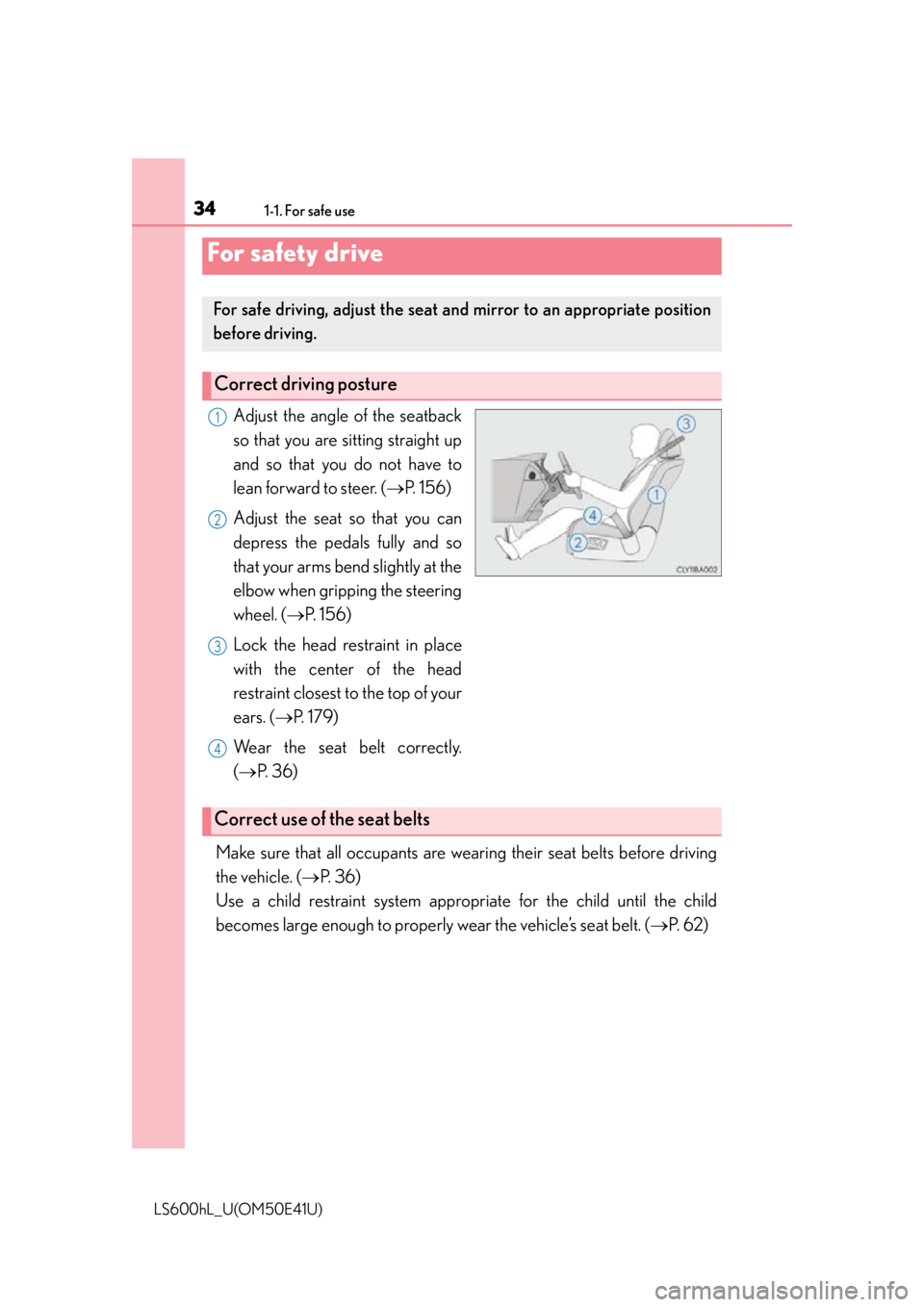
341-1. For safe use
LS600hL_U(OM50E41U)
Adjust the angle of the seatback
so that you are sitting straight up
and so that you do not have to
lean forward to steer. ( P. 1 5 6 )
Adjust the seat so that you can
depress the pedals fully and so
that your arms bend slightly at the
elbow when gripping the steering
wheel. ( P. 1 5 6 )
Lock the head restraint in place
with the center of the head
restraint closest to the top of your
ears. ( P. 1 7 9 )
Wear the seat belt correctly.
( P. 36)
Make sure that all occupants are we aring their seat belts before driving
the vehicle. ( P. 36)
Use a child restraint system appropriate for the child until the child
becomes large enough to properly wear the vehicle’s seat belt. ( P. 6 2 )
For safety drive
For safe driving, adjust the seat and mirror to an appropriate position
before driving.
Correct driving posture
1
2
3
4
Correct use of the seat belts
Page 40 of 620
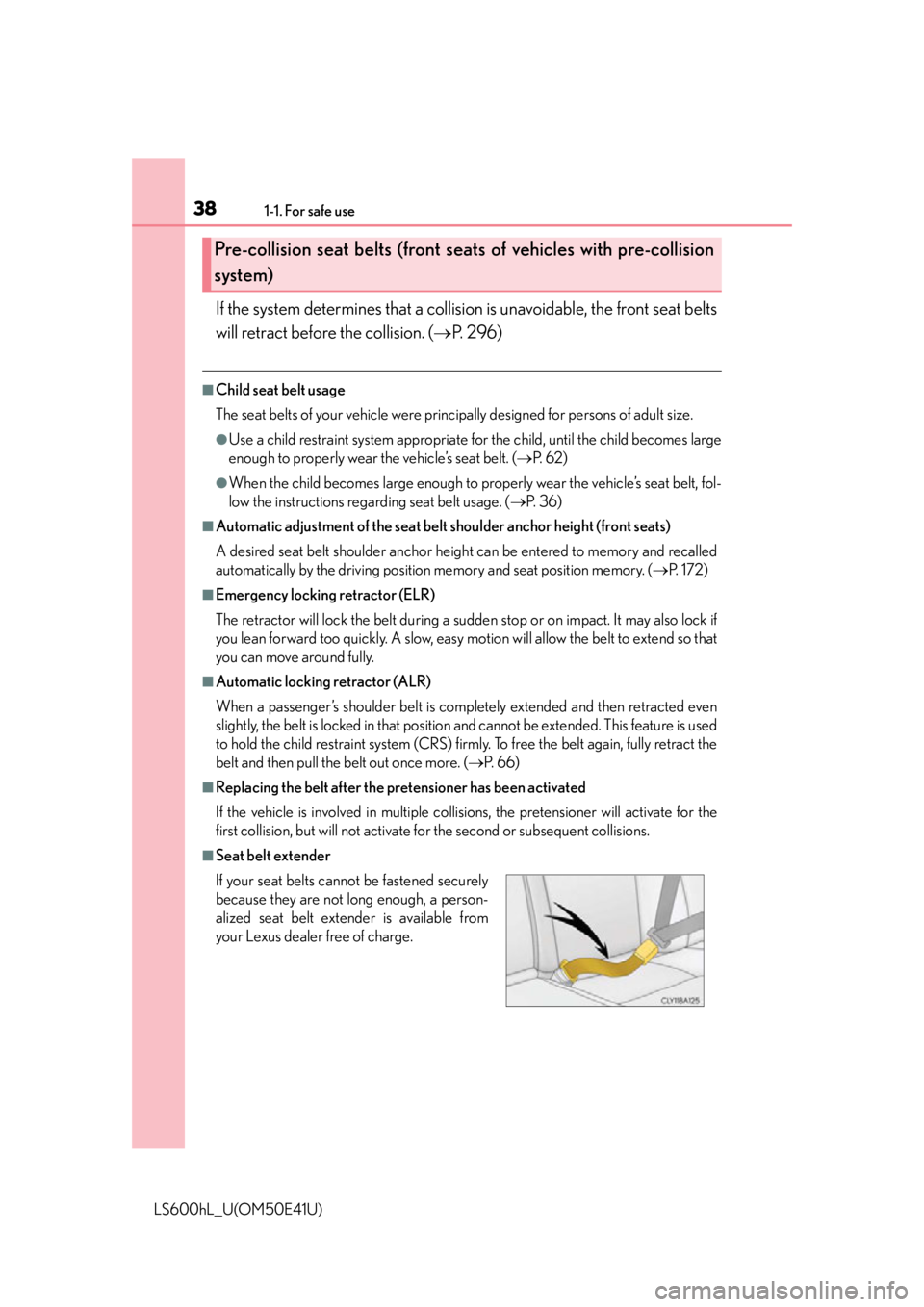
381-1. For safe use
LS600hL_U(OM50E41U)
If the system determines that a collision is unavoidable, the front seat belts
will retract before the collision. ( P. 2 9 6 )
■Child seat belt usage
The seat belts of your vehicle were princi pally designed for persons of adult size.
●Use a child restraint system appropriate for the child, until the child becomes large
enough to properly wear the vehicle’s seat belt. ( P. 6 2 )
●When the child becomes large enough to properly wear the vehicle’s seat belt, fol-
low the instructions regarding seat belt usage. ( P. 3 6 )
■Automatic adjustment of the seat belt shoulder anchor height (front seats)
A desired seat belt shoulder anchor height can be entered to memory and recalled
automatically by the driving position memory and seat position memory. (P. 1 7 2 )
■Emergency locking retractor (ELR)
The retractor will lock the belt during a sudden stop or on impact. It may also lock if
you lean forward too quickly. A slow, easy motion will allow the belt to extend so that
you can move around fully.
■Automatic locking retractor (ALR)
When a passenger’s shoulder belt is comp letely extended and then retracted even
slightly, the belt is locked in that position and cannot be extended. This feature is used
to hold the child restraint system (CRS) firmly. To free the belt again, fully retract the
belt and then pull the belt out once more. ( P. 66)
■Replacing the belt after the pretensioner has been activated
If the vehicle is involved in multiple collisions, the pretensioner will activate for the
first collision, but will not activate for the second or subsequent collisions.
■Seat belt extender
Pre-collision seat belts (front sea ts of vehicles with pre-collision
system)
If your seat belts cann ot be fastened securely
because they are not long enough, a person-
alized seat belt extender is available from
your Lexus dealer free of charge.
Page 42 of 620
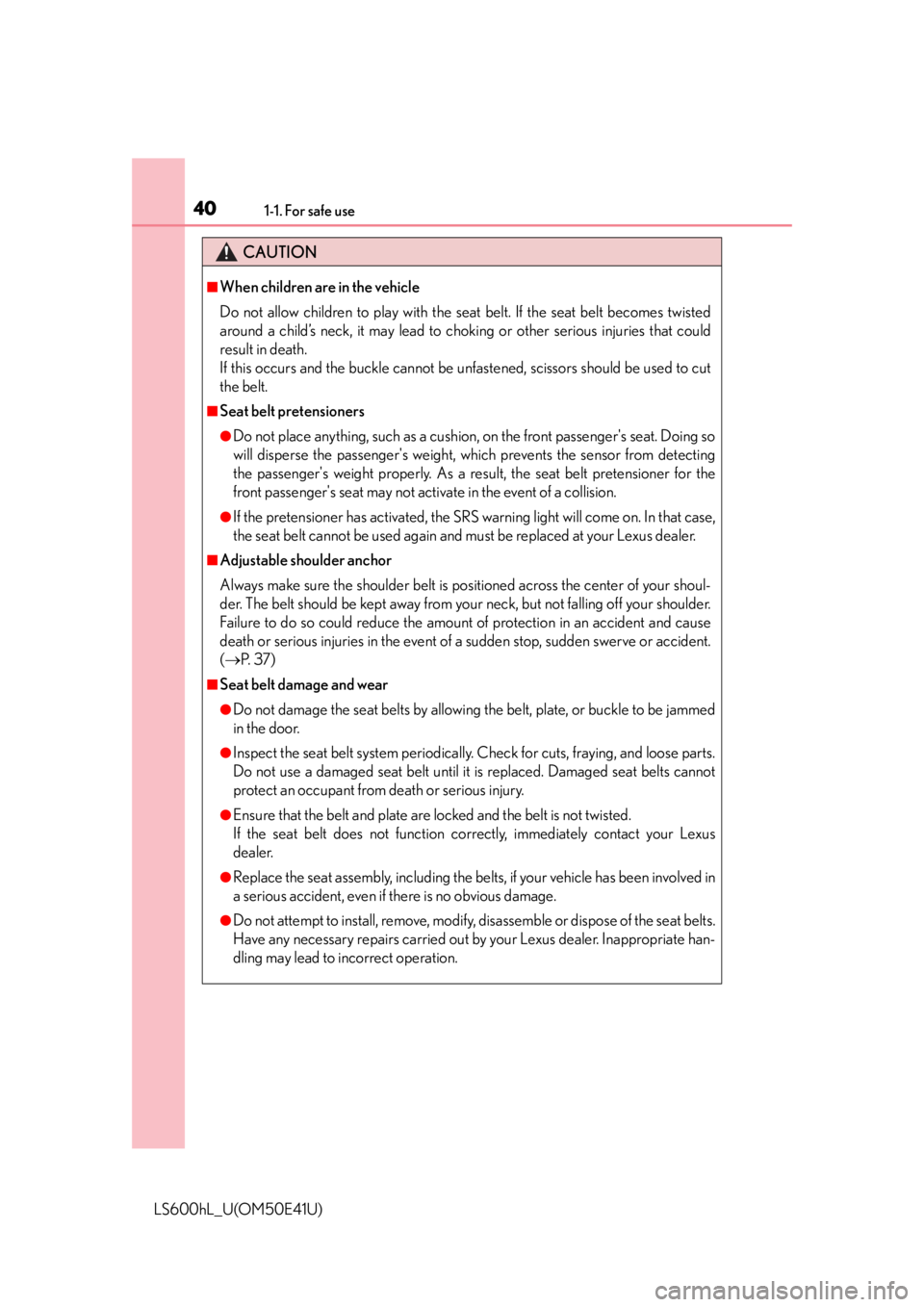
401-1. For safe use
LS600hL_U(OM50E41U)
CAUTION
■When children are in the vehicle
Do not allow children to play with the seat belt. If the seat belt becomes twisted
around a child’s neck, it may lead to choking or other serious injuries that could
result in death.
If this occurs and the buckle cannot be unfastened, scissors should be used to cut
the belt.
■Seat belt pretensioners
●Do not place anything, such as a cushion, on the front passenger's seat. Doing so
will disperse the passenger's weight, wh ich prevents the sensor from detecting
the passenger's weight properly. As a resu lt, the seat belt pretensioner for the
front passenger's seat may not activate in the event of a collision.
●If the pretensioner has activated, the SRS warning light will come on. In that case,
the seat belt cannot be used again and must be replaced at your Lexus dealer.
■Adjustable shoulder anchor
Always make sure the shoulder belt is positioned across the center of your shoul-
der. The belt should be kept away from yo ur neck, but not falling off your shoulder.
Failure to do so could reduce the amount of protection in an accident and cause
death or serious injuries in the event of a sudden stop, sudden swerve or accident.
( P. 3 7 )
■Seat belt damage and wear
●Do not damage the seat belts by allowing the belt, plate, or buckle to be jammed
in the door.
●Inspect the seat belt system periodically. Check for cuts, fraying, and loose parts.
Do not use a damaged seat belt until it is replaced. Damaged seat belts cannot
protect an occupant from death or serious injury.
●Ensure that the belt and plate are locked and the belt is not twisted.
If the seat belt does not function correctly, immediately contact your Lexus
dealer.
●Replace the seat assembly, including the belts, if your vehicle has been involved in
a serious accident, even if there is no obvious damage.
●Do not attempt to install, remove, modify, disassemble or dispose of the seat belts.
Have any necessary repairs carried out by your Lexus dealer. Inappropriate han-
dling may lead to incorrect operation.
Page 46 of 620
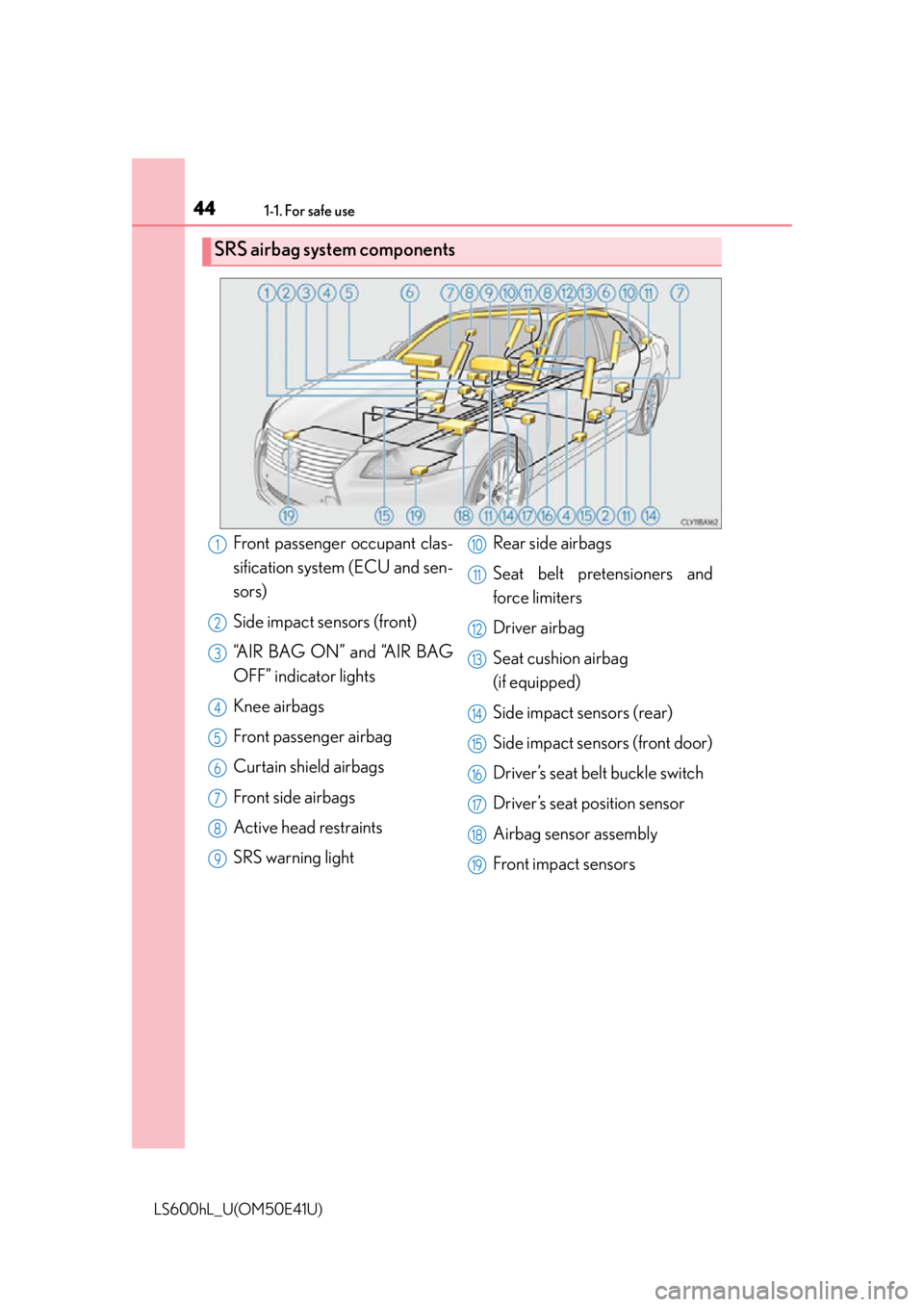
441-1. For safe use
LS600hL_U(OM50E41U)
SRS airbag system components
Front passenger occupant clas-
sification system (ECU and sen-
sors)
Side impact sensors (front)
“AIR BAG ON” and “AIR BAG
OFF” indicator lights
Knee airbags
Front passenger airbag
Curtain shield airbags
Front side airbags
Active head restraints
SRS warning lightRear side airbags
Seat belt pretensioners and
force limiters
Driver airbag
Seat cushion airbag
(if equipped)
Side impact sensors (rear)
Side impact sensors (front door)
Driver’s seat belt buckle switch
Driver’s seat position sensor
Airbag sensor assembly
Front impact sensors1
2
3
4
5
6
7
8
9
10
11
12
13
14
15
16
17
18
19
Page 47 of 620

451-1. For safe use
1
For safety and security
LS600hL_U(OM50E41U)
Your vehicle is equipped with ADVANCED AIRBAGS designed based
on the US motor vehicle safety standards (FMVSS208). The airbag sen-
sor assembly (ECU) controls airbag deployment based on information
obtained from the sensors etc. show n in the system components diagram
above. This information includes crash severity and occupant information.
As the airbags deploy, a chemical reaction in the inflators quickly fills the
airbags with non-toxic gas to help restrain the motion of the occupants.
CAUTION
■SRS airbag precautions
Observe the following precautions regarding the SRS airbags.
Failure to do so may caus e death or serious injury.
●The driver and all passengers in the vehi cle must wear their seat belts properly.
The SRS airbags are supplemental devices to be used with the seat belts.
●The SRS driver airbag deploys with considerable force, and can cause death or
serious injury especially if the driver is very close to the airbag. The National
Highway Traffic Safety Admi nistration (NHTSA) advises:
Since the risk zone for the driver’s airbag is the first 2 - 3 in. (50 - 75 mm) of
inflation, placing yourself 10 in. (250 mm) from your driver airbag provides you
with a clear margin of safety. This distance is measured from the center of the
steering wheel to your breastbone. If you sit less than 10 in. (250 mm) away now,
you can change your driving position in several ways:
• Move your seat to the rear as far as you can while still reaching the pedals comfortably.
• Slightly recline the back of the seat. Although vehicle designs vary, many drivers can achieve the 10 in. (250 mm)
distance, even with the driver seat all the way forward, simply by reclining the
back of the seat somewhat. If reclining the back of your seat makes it hard to
see the road, raise yourself by using a fi rm, non-slippery cushion, or raise the
seat if your vehicle has that feature.
• If your steering wheel is adjustable, ti lt it downward. This points the airbag
toward your chest instead of your head and neck.
The seat should be adjusted as reco mmended by NHTSA above, while still
maintaining control of the foot pedals, steering wheel, and your view of the
instrument panel controls.
Page 52 of 620

501-1. For safe use
LS600hL_U(OM50E41U)
■If the SRS airbags deploy (inflate)
●Bruising and slight abrasions may result from contact with a deploying (inflating)
SRS airbag.
●A loud noise and white powder will be emitted.
●Parts of the airbag module (steering wheel hub, airbag cover and inflator) as well as
the seats, parts of the front and rear pillars, and roof side rails may be hot for several
minutes. The airbag it self may also be hot.
●The windshield may crack.
●For Lexus Enform Safety Connect subscriber s, if the SRS airbags deploy or in the
event of a severe rear-end collision, the system is designed to send an emergency
call to the response center, notifying them of the vehicle’s location (without needing
to push the “SOS” button) and an agent wi ll attempt to speak with the occupants to
ascertain the level of emergency and assistance required. If the occupants are
unable to communicate, the agent automatically treats the call as an emergency
and helps to dispatch the necessary emergency services. ( P. 4 1 0 )
■SRS airbag deployment conditions (SRS front airbags and SRS seat cushion air-
bag)
●The SRS front airbags and SRS seat cushion airbag will deploy in the event of an
impact that exceeds the set threshold level (the level of force corresponding to an
approximately 12 - 18 mph [20 - 30 km/h] frontal collision with a fixed wall that
does not move or deform).
However, this threshold velocity will be considerably higher in the following situa-
tions:
• If the vehicle strikes an object, such as a parked vehicle or sign pole, which can move or deform on impact
• If the vehicle is involved in an underride collision, such as a collision in which the front of the vehicle “underrides”, or goes under, the bed of a truck
●Depending on the type of collision, it is po ssible that only the seat belt pretension-
ers will activate.
●The SRS front airbags for the front passenger will not activate if there is no passen-
ger sitting in the front passenger seat. Ho wever, the SRS front airbags for the front
passenger may deploy if luggage is put in the seat, even if the seat is unoccupied.
( P. 5 5 )
Page 57 of 620
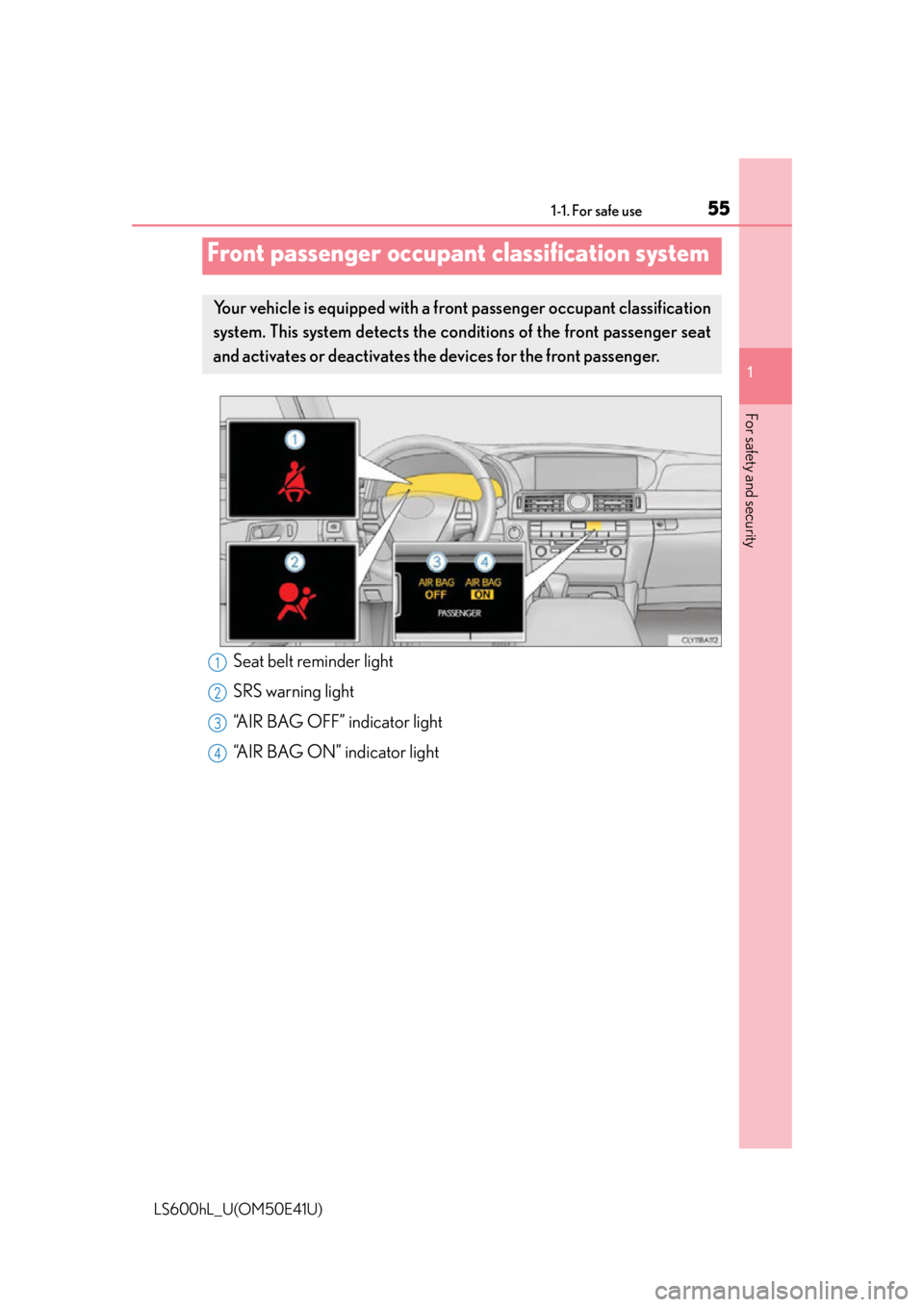
551-1. For safe use
1
For safety and security
LS600hL_U(OM50E41U)
Front passenger occupant classification system
Your vehicle is equipped with a front passenger occupant classification
system. This system detects the cond itions of the front passenger seat
and activates or deactivates the devices for the front passenger.
Seat belt reminder light
SRS warning light
“AIR BAG OFF” indicator light
“AIR BAG ON” indicator light1
2
3
4
Page 58 of 620
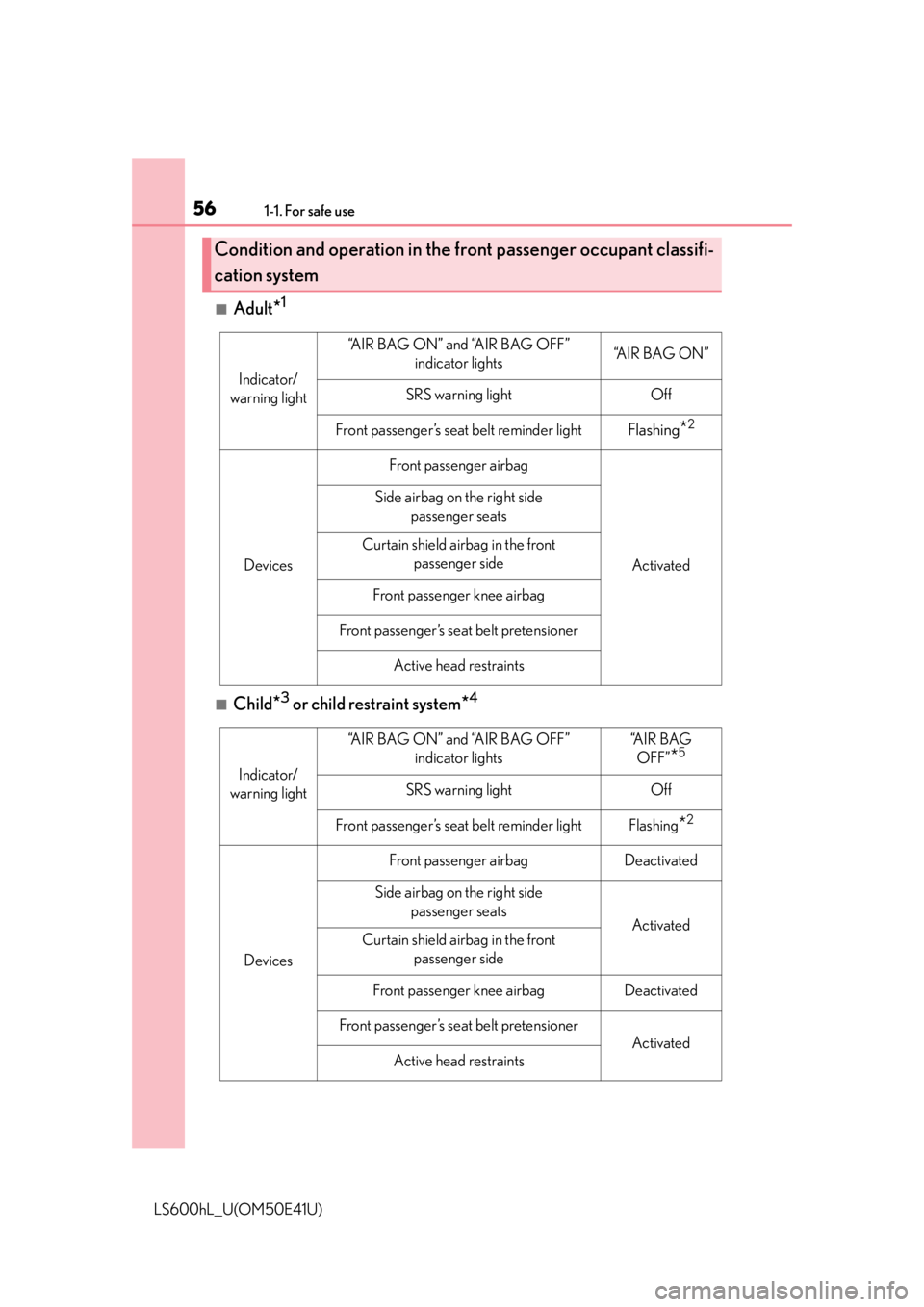
561-1. For safe use
LS600hL_U(OM50E41U)
■Adult*1
■Child*3 or child restraint system*4
Condition and operation in the front passenger occupant classifi-
cation system
Indicator/
warning light
“AIR BAG ON” and “AIR BAG OFF” indicator lights“A I R B A G O N ”
SRS warning lightOff
Front passenger’s seat belt reminder lightFlashing*2
Devices
Front passenger airbag
Activated
Side airbag on the right side
passenger seats
Curtain shield airbag in the front passenger side
Front passenger knee airbag
Front passenger’s seat belt pretensioner
Active head restraints
Indicator/
warning light
“AIR BAG ON” and “AIR BAG OFF” indicator lights“A I R B A G OFF”
*5
SRS warning lightOff
Front passenger’s seat belt reminder lightFlashing*2
Devices
Front passenger airbagDeactivated
Side airbag on the right side
passenger seats
ActivatedCurtain shield airbag in the front passenger side
Front passenger knee airbagDeactivated
Front passenger’s seat belt pretensioner
Activated
Active head restraints